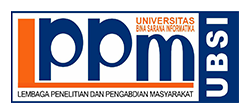Klasifikasi Anak Berkebutuhan Khusus Tunagrahita Menggunakan Metode Algoritma C4.5
DOI:
https://doi.org/10.31294/paradigma.v24i1.1087Keywords:
The child with special needed, Decission Tree C4.5, TunagrahitaAbstract
Children with mental retardation are children who have differences from other children that can be seen significantly with our naked eyes, because they are children with special needs both mentally, physically and can be seen from their psychology. Intellectuals of mentally retarded children are socially slower to do everything in achieving the goals they want optimally. Children with mental retardation usually have disorders such as speech disorders or physical and mental disabilities, as well as uncontrollable emotions. The problems that exist with teachers of children with special needs are because many teachers do not know the characteristics of mentally retarded children and how to handle them through IQ levels and several other factors. In solving problems for children with special needs, these children need to be classified due to their differences from one person to another in developmental delays and physical conditions they experience, so it is necessary to distinguish educational or teaching strategies that are designed and programmed for them. With the C4.5 algorithm method, which can classify children with special needs based on existing characteristics with data that is tested with a model that is used cross validation and evaluated with a confusion matrix. Based on the results of testing with this method, the accuracy obtained is very high so that it can be used by teaching staff from the accurate information.
References
Arifin, T. (2015). Metode Data Mining Untuk Klasifikasi Data Sel Nukleus Dan Sel Radang Berdasarkan Analisa Tekstur. Informatika, II(2), 425–433.
Fitriyani, F. (2018). Metode Bagging Untuk Imbalance Class Pada Bedah Toraks Menggunakan Naive Bayes. Jurnal Kajian Ilmiah, 18(3), 278. https://doi.org/10.31599/jki.v18i3.281
Grand, & Indrajit, R. E. (2017). Aplikasi Deteksi Dini untuk Mengenali Anak Berkebutuhan Khusus Menggunakan Metode Business Intellegence. Seminar Nasional Sains Dan Teknologi, November, 1–11.
Hormann, A. M. (1964). Programs for machine learning. Part II. Information and Control, 7(1), 55–77. https://doi.org/10.1016/S0019-9958(64)90259-1
Nasirudin, N., Setiawan, I., & Yani, A. (2016). Modul Guru Pembelajar PJOK. Journal Education, 2016.
Putri, Z. S., Putri, R. R. M., & Indriati. (2017). Deteksi Autisme pada Anak Menggunakan Metode Modified K-Nearest Neighbor (MKNN). Jurnal Pengembangan Teknologi Informasi Dan Ilmu Komputer, 1(2), 37–43.
SARI, S. F. M., BINAHAYATI BINAHAYATI, & TAFTAZANI, B. M. (2017). Pendidikan Bagi Anak Tuna Grahita (Studi Kasus Tunagrahita Sedang Di Slb N Purwakarta). Prosiding Penelitian Dan Pengabdian Kepada Masyarakat, 4(2), 217–222. https://doi.org/10.24198/jppm.v4i2.14273
Sugara, B., Widyatmoko, D., Prakoso, B. S., & Saputro, D. M. (2018). Penerapan Algoritma C4.5 untuk Deteksi Dini Autisme Pada Anak. Seminar Nasional Teknologi Informasi Dan Komunikasi (SENTIKA), 2018(Sentika), 87–96.
Downloads
Published
How to Cite
Issue
Section
License
Copyright (c) 2022 I Made Dananjaya Priyatama, Ridwansyah

This work is licensed under a Creative Commons Attribution-ShareAlike 4.0 International License.
Paradigma is an open-access article distributed under the terms of the Creative Commons Attribution-ShareAlike 4.0 International License (https://creativecommons.org/licenses/by-sa/4.0/) , This license permits: Share — copy and redistribute the material in any medium or format for any purpose, even commercially, Adapt — remix, transform, and build upon the material for any purpose, even commercially.




















 Jl. Kramat Raya No.98, Kwitang, Kec. Senen, Kota Jakarta Pusat, DKI Jakarta 10450
Jl. Kramat Raya No.98, Kwitang, Kec. Senen, Kota Jakarta Pusat, DKI Jakarta 10450
